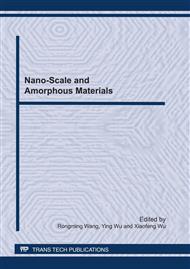p.141
p.148
p.153
p.158
p.162
p.168
p.175
p.180
p.186
Monodispersed Protein Stabilized Silver Nanoprisms: Synthesis, Optical Properties and Surface-Enhanced Raman Scattering Application
Abstract:
Protein stabilized, water soluble silver nanoparticles are essential for biomedicine and biotechnology. The abundant protein such as gelatin and bovine serum albumin (BSA) has a remarkable ability of binding and transporting materials across cell membrane that makes it ideal for drug delivery and very useful for pharmaceutical industry. In this article, silver nanoprisms were synthesized by reacting an aqueous solution of silver nitrate with proteins such as gelatin and bovine serum albumin at different conditions, where proteins provided the dual function of Ag (I) reduction and Ag(0) prism-like structures formation. The solution exhibited an excellent colloidal stability by the visible observation. UV-vis spectra and transmission electron microscopy (TEM), revealed the formation of well-dispersed Ag nanoprisms with different sizes. Furthermore, the fluorescence intensity of proteins was drastically quenched in presence of Ag nanoprisms from the results of fluorescence spectra. The surface enhanced Raman scattering spectrum of anisotropic silver nanoprisms was also presented.
Info:
Periodical:
Pages:
162-167
Citation:
Online since:
June 2011
Authors:
Keywords:
Price:
Сopyright:
© 2011 Trans Tech Publications Ltd. All Rights Reserved
Share:
Citation:


